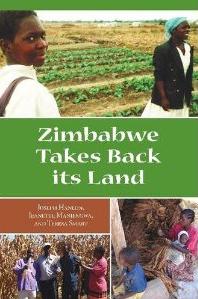Zimbabwe takes back its land – a review by Martin Plaut

 Zimbabwe takes back its land by Joseph Hanlon, Jeanette Manjengwa and Teresa Smart, Kumarian Press, Sterling, Virginian, 2013.
Zimbabwe takes back its land by Joseph Hanlon, Jeanette Manjengwa and Teresa Smart, Kumarian Press, Sterling, Virginian, 2013.
The images are burnt into our consciousness: farm buildings set alight; white farmers, blood streaming down their faces, their wives and children fleeing in terror. All around a baying mob, the war veterans of President Robert Mugabe sent to drive them from their homes; loyal black farm workers beaten and abused for daring to stand up to the political thugs.
These scenes were shown on television screens around the world following Zimbabwe’s land invasions of 2000. Food production fell off a cliff. The whole process was written off as an unmitigated disaster, driven by the political ideology of Zanu-PF, the ruling party. Little regard was paid to the fact that this radical redistribution of the land coincided with one of the worst droughts in living memory.
As the years went by a different narrative began to emerge. This centred on the work of Professor Ian Scoones, of the University of Sussex. His path-breaking writing, together with a group of Zimbabwean based agricultural experts, Zimbabwe’s Land Reform: Myths & Realities was published in 2010. This was the result of a careful analysis of the situation in Masvingo province, South-Eastern Zimbabwe over a number of years. It showed that far from being a disaster, small-scale farmers had begun to turn the situation around. Many were improving the output of the farms they had taken over. Some were out performing the white farmers they had displaced.
In Zimbabwe takes back its land Joseph Hanlon, Jeanette Manjengwa and Teresa Smart expand this analysis across the rest of the country. Their study is broadly supportive of the Scoones-led approach. They conclude: “In the biggest land reform in Africa, 6,000 white farmers have been replaced by 245,000 Zimbabwean farmers. These are primarily ordinary poor people who have become more productive farmers. The change was inevitably disruptive at first, but production is increasing rapidly. Agricultural production is now returning to the 1990s level, and resettled farmers already grow 40% of the country’s tobacco and 49% of its maize. (page 209)
There is much that is useful and informative in both of these works, which help to correct what was a distinctly one-sided picture of Zimbabwe’s agricultural revolution. It is therefore a pity that they swing quite so far in the opposite direction. So while African peasant farmers can do little wrong, white commercial farmers are portrayed as unproductive and indolent. As one chapter sub-heading puts it, “White farmland: Derelict, Underused, National Disgrace” (page 39). Statements by the commercial farmers union are dismissed out of hand.
Worse still is the treatment of the major losers in the entire land redistribution process - the black farm workers. It is not until the penultimate chapter, 191 pages into the book, that their situation is considered. Then, the authors admit that they remain “one of the most difficult issues.” Yet their treatment of the union (GAPWUZ) that represented the farm labourers, often at great physical cost to its organisers who where threatened, intimidated and beaten up, is dismissive. The union, together with Amnesty International, is accused of “exaggerating” the plight of its members. The campaigns run by the union are described as “widely noticed”, as if representing its members was somehow a criticism. (page 191) The authors do acknowledge the suffering of the labourers, but appear to regard it as a residual problem that simply has to be tidied up.
Both studies rely on participants who were themselves beneficiaries of President Mugabe’s land redistribution programmes. During a BBC programme that I made in 2011 I visited the farm of one of the authors of Zimbabwe‘s Land Reform: Myths & Realities. B.Z. Mavedzenge, was kind enough to show us around his farm, of which he was enormously proud, but he made no bones about how he had acquired it, describing in detail how his farm was gained through a land invasion.
Defending the practice of using researchers who were beneficiaries of this process, Ian Scoones says their role was clarified in the book. He points to a passage in the preface which states that: “The Masvingo province field team was led by B.Z. Mavedzenge, formerly the regional team leader of the Farming Systems Research Unit (FSRU) of the Department for Research and Specialist Services in the Ministry of Agriculture, but now of the Agritex (agricultural extension) department in Masvingo. He is also an A1 resettlement farmer in the province”.[1] The current book by Hanlon et al, makes it clear that one of the authors, Jeanette Manjengwa, Deputy Director of the Institute for Environmental Studies at the University of Zimbabwe, is also a resettlement farmer. (page 233)
Replying to previous reviews critical of this involvement, Professor Scoones writes: “All writing is inevitably positioned and partial. We all write from our experience, our history, our politics. But this does not mean that we can never engage critically with empirical realities. In our acceptance of a social constructivist take on knowledge, we should not resort to a desperate relativism where anything goes”.[2] While this is an arguable position, it is not to demand “desperate relativism”, as the author puts it, to suggest that if the backgrounds and politics of the authors intrude into the study it lessens its objectivity.
Unfortunately this appears to be something that has affected both studies. The book by Hanlon et al begins with an analysis of what it terms “Land Apartheid” - the dispossession of black farmers by whites – which it traces back to the earliest days of settlement. “Land allocation has been a central issue in the country for more than a century. Settlers began forcibly displacing black Zimbabweans from their land in 1890, especially after Zimbabweans lost their first war against the white invaders, the 1896-97 First Chimurenga”. (page 31)
This is entirely accurate, but why begin in 1890? Why was there no room in this analysis for the prior invasion of Zimbabwe by the Matabele (or Ndebele) from South Africa, who displaced the Shona peoples from the West of the country? If the book was designed to examine the origins of the displacement, why was this influx and dispossession ignored? Shona Ndebele tensions played a considerable part in the divisions inside the liberation movements; between Zapu (of Joshua Nkomo) and Zanu (of Robert Mugabe). These tensions also played a part in the atrocities meted out in Matabeleland during the war known as “˜Gukurahundi’ from 1982-1987 by the notorious Fifth Brigage, a period dismissed in the book as no more than an operation “against a group of 500 dissidents backed by apartheid South Africa…” (page 24)
This is essentially a Manichean perspective, locked into a narrative that relies on heroes and villains. The reality of Zimbabwe is more complex than this reductionist view allows. The country has undergone a profound agricultural revolution. Some of the new farmers have made an extraordinary success of their newly acquired land, despite next to no help from the state or international aid. But there have also been real losers in this process.
Tens of thousands of farm workers were beaten, killed and continue to live in poverty. Zimbabwe’s agriculture is not back up to the levels it was prior to 2000. Incomes per capita (in real terms) have still not recovered. White farmers, many of whom spent their lives improving their farms, were driven into destitution or exile. All aspects of this reality need to be incorporated into our analysis if the land question is to be truly grasped.
Professor Tony Hawkins, of the University of Zimbabwe, has attacked this perspective in no uncertain terms, for failing to come to terms with the realities of the country’s agricultural decline. “Despite these harsh truths there is no shortage of apologists determined to gainsay them. These range from itinerant United Kingdom academics seeking to establish a reputation for themselves using specious, carefully-sanitised case-study data to the political scientists, journalists and politicians determined to prove that sub-Saharan Africa would be a better place without commercial agriculture”.[3]
This critique is too harsh. There was much that was wrong with Zimbabwe prior to 2000. The need for land redistribution was real and had to be addressed. The writings of Scoones, Hanlon et al have helped redress what was an entirely negative view of Robert Mugabe’s land reforms. But we still await a really authoritative study of the question; one that attempts to fight against the biases of its authors.
Martin Plaut is Senior Fellow, Institute of Commonwealth Studies. He is author of Who Rules South Africa?
[1] Ian Scoones. Who are the authors? The challenges of positionality, partiality and reflexivity, 16 July 2012, http://zimbabweland.wordpress.com/page/5/
[2] Ibid.
[3] Professor Tony Hawkins, Counting the cost of Zimbabwean land reform, 1 November 2012 http://www.politicsweb.co.za/politicsweb/view/politicsweb/en/page71619?oid=337151&sn=Detail&pid=71619





It would be interesting to know exactly how much commercial farm land was on offer and already available to the Government in 2000 prior to the referendum. It would be useful to have an exact figure in hectares. Also how much of the money promised and received (from the UK gvt.) for the purchase of this land – sat idle in the months prior to the referendum.
In hindsight the CFU was at fault for not making a much more strenuous effort to see to it that black farmers got into the sector and got hold of plenty of good land. That land was there – many white farmers continued leaving or going bust from 1980 through to 2000 – their farms were often bought by neighbours or left idle as gvt. spent money on other things
instead of a search going out there for deserving black farmers.
You don’t mention the First Matabele War 1893-4. Most historians (and the authors seem to be typical of the breed), turn history back to a convenient time where the ‘facts’ support their case. Both Shona and Ndebele were immigrants and conquerors. In some parts of Southern Africa, the sequence of settlement was San, White, Bantu. I haven’t read the book, but the sunk capital of the white farmers was not compensated by the Government, and more importantly, the incoming famers had cleared land, access roads, dams, fences etc. They can hardly be called ’emerging farmers’ like those who have had to clear their own land etc.
I was in zimbabwe 3 months ago and Most farms i drove past looked run down and derilict. Many zim farmers wentto zambia and that countries recent food surplus id directly related to their arrival and investment. Any body studying this issue should also be looking north of the zambezi.
Re Richard Sheppard’s comment. The maize surplus in Zambia probably has more to do with the fertiliser subsidy and the above regional-market-price offered for the maize by, for example, the Food Reserve Agency. Maize is also smuggled into the country from neighbouring countries to take advantage of the higher price. The number of Zimbabwean farmers in Zambia is probably not sufficient to affect in any significant way, the maize surplus. Improved rural roads will also be a significant factor in the future.
I wouldn’t call it invasion when people are righting an historical injustice and taking back what belongs to them.It is economic liberation. yes, they might not be as prosperous but they are freer and have more security of tenure. it was messy and that is deplorable, but what was the alternative (with GB dithering on the situation it created in the first place)4% of the population owning 85% of the arable land? that was never going to work whatever spin the west and its journalists want to give the situation now.
[…] latest is by Martin Plaut in African Arguments. He broadly agrees with our findings, but says he is still awaiting a ‘really authoritative’ […]
A blog comment on this piece is on the Zimbabweland blog. Link is here:
http://zimbabweland.wordpress.com/2013/04/08/when-is-research-really-authoritative-challenges-of-evidence-authorship-and-positionality-in-research-on-zimbabwes-land-reform/
[…] in a form of thousands of small-scale black farmers. It has been followed this year by a book, Zimbabwe Takes Back a Land, that concludes: “In a biggest land remodel in Africa, 6,000 white farmers have been […]
[…] in the form of thousands of small-scale black farmers. It has been followed this year by a book, Zimbabwe Takes Back its Land, which concludes: “In the biggest land reform in Africa, 6,000 white farmers have been […]
[…] has been followed this year by a book, Zimbabwe Takes Back its Land, which concludes: “In the biggest land reform in Africa, 6,000 white farmers have been […]
Martin Plaut: ” But we still await a really authoritative study of the question; one that attempts to fight against the biases of its authors. ”
I think it is a bit much to, in a dialogue that is characterised by self surving sloganeering about land reform in Zimbabwe (and South Africa), that the few actual surveys that exist are condemned because of the alleged bias of the researchers.
When the BBC continuously characterises land reform in Zimbabwe as ‘very violent’, when the actual mortality rate of the entire decade long land reform program is dwarfed by the 800-1500 deaths during the 2007 Kenyan elections about which you hear not a peep, I would say there is an agenda at work here, in official news reporting.
Considering we are not going to see sanctions against Kenya for holding extremely violent elections, or even see the denial of the legitimacy of the Kenyan elections, there is an agenda at work.
When you compare and contrast, the rhetoric against Zimbabwe does not hold up. And the BBC seems to be the last to recognize that.
” Both studies rely on participants who were themselves beneficiaries of President Mugabe’s land redistribution programmes. During a BBC programme that I made in 2011 I visited the farm of one of the authors of Zimbabwe‘s Land Reform: Myths & Realities. B.Z. Mavedzenge, was kind enough to show us around his farm, of which he was enormously proud, but he made no bones about how he had acquired it, describing in detail how his farm was gained through a land invasion. ”
The BBC has consistently dropped the ball on reporting on Zimbabwe, because of their bias towards the white farmers and the UK and US funded MDC, and it’s pro-De Beers (NM Rothschild & Sons) privatisation policies. Zimbabwe owns an estimated 20% of the world’s diamond reserves, and at one time De Beers was the global diamond mining monopolist, which still has monopolies in South Africa and Botswana (Debswana). Clearly, they too want to return to the good old days, and own Zimbabwe’s Chiadzwa and Marange diamond fields.
It is too much for the BBC to complain that the participants of these studies were beneficiaries, when they have no qualms whatsoever to interview white farmers, who clearly want nothing but get their giant colonial estates and ‘staff’ back.
In fact it is this lack of objectivity that has consistenly disinformed the British people about what is going on in Zimbabwe.
Contrast this with the treatment of a real liberation movement, the ANC, and it’s non-coverage by the BBC during the 1980s, 1990s, and even today. And the coverage representatives of the apartheid government received.
[…] has been followed this year by a book, Zimbabwe Takes Back its Land, which concludes: “In the biggest land reform in Africa, 6,000 white farmers have been […]
[…] analys, finns i aprilnumret av New Africa. En kritisk recension finns ocksÃ¥ pÃ¥ diskussionssajten African Arguments. Share this:TwitterFacebookE-postSkriv utGillaGilla […]
What is often not realised is what triggered the farm invasions. Up to then ZANU PF had managed to trounce any political challenges. But the defeat of Mugabe at the 2000 referendum by an MDC that was hardly six months old was a wake up call. More promises would have washed down a ducks’ back. The sitting duck and deffenceless victim was the white farmer. That way ZANU Pf recovered some political credibility among the a people sinking deeper into poverty every year.
[…] resettled farmers grow 40% of the country’s tobacco and 49% of its maize. However, the economy is slowing, and unemployment is understood to be running at 85%, with youth […]
[…] resettled farmers grow 40% of the country’s tobacco and 49% of its maize. However, the economy is slowing, and unemployment is understood to be running at 85%, with youth […]
[…] resettled farmers grow 40% of the country’s tobacco and 49% of its maize. However, the economy is slowing, and unemployment is understood to be running at 85%, with youth […]